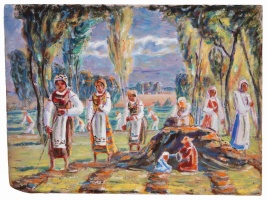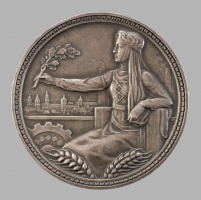.jpg)

Flowers and fruit
| Author: | Adomas Galdikas (1893–1969) |
Adomas Galdikas was a painter, graphic artist, scenographer and teacher. He was born on 18 October 1893 on a Giršnai homestead near Mosėdis, (now Skuodas district). In 1912–1917 he attended the A. Stieglitz School of Art in St. Petersburg. In 1918 he returned to Lithuania and taught drawing at the Saulės Teachers’ Seminary and at a Gymnasium in Kaunas. During the period of 1923–1940 he lectured on drawing at the Kaunas School of Art, supervised the graphics studio and educated many famous Lithuanian graphic artists. In 1931 he opened his personal exhibition in Paris. In the world exhibition in Paris (1937) he was awarded Grand Prix and a golden medal. In 1940–1944 he taught drawing at the Kaunas Institute of Applied and Decorative Art. In 1944 he emigrated from Lithuania and in 1946–1947 he lectured at the School of Applied Art in Freiburg. Between 1947 and 1952 he lived and worked in Paris, and in 1952 took up residence in New York, USA. A. Galdikas’ art is extensive and varied (graphics, paintings, sketches of postal marks and Lithuanian money, and scenography). He taught art as well. He collected Lithuanian folk art, admired ancient sculpture, carvings, small architecture, ceramics and folk musical instruments, which he used as motifs in his art. He died in 1969 in New York.
Adomas Galdikas educated many famous artists at the Kaunas School of Art and the Freiburg School of Applied Arts. In 1947–1952, he lived in Paris and later, in New York. He created sketches for Lithuanian money and postmarks, and worked in scenography. He collected articles of Lithuanian folk art and national musical instruments. A. Galdikas was always good at painting autumn: the mood and composition were different, but the feeling of maturity always remained. Even the abstractions, created in emigration, are often related to the colouring of autumn or gusts of the autumn winds. The artist used various techniques, but gouache and tempera were most suitable for creating images of the changing states of nature.
Source: Valiunas Ellex (LAWIN until 2015) art album: THE WORLD OF LANDSCAPES I (2010). Compilers Nijolė Tumėnienė, Dalia Tarandaitė, Jurgita Semenauskienė. Text author Nijolė Tumėnienė.

Adomas Galdikas was a painter, graphic artist, scenographer and teacher. He was born on 18 October 1893 on a Giršnai homestead near Mosėdis, (now Skuodas district). In 1912–1917 he attended the A. Stieglitz School of Art in St. Petersburg. In 1918 he returned to Lithuania and taught drawing at the Saulės Teachers’ Seminary and at a Gymnasium in Kaunas. During the period of 1923–1940 he lectured on drawing at the Kaunas School of Art, supervised the graphics studio and educated many famous Lithuanian graphic artists. In 1931 he opened his personal exhibition in Paris. In the world exhibition in Paris (1937) he was awarded Grand Prix and a golden medal. In 1940–1944 he taught drawing at the Kaunas Institute of Applied and Decorative Art. In 1944 he emigrated from Lithuania and in 1946–1947 he lectured at the School of Applied Art in Freiburg. Between 1947 and 1952 he lived and worked in Paris, and in 1952 took up residence in New York, USA. A. Galdikas’ art is extensive and varied (graphics, paintings, sketches of postal marks and Lithuanian money, and scenography). He taught art as well. He collected Lithuanian folk art, admired ancient sculpture, carvings, small architecture, ceramics and folk musical instruments, which he used as motifs in his art. He died in 1969 in New York.
Adomas Galdikas educated many famous artists at the Kaunas School of Art and the Freiburg School of Applied Arts. In 1947–1952, he lived in Paris and later, in New York. He created sketches for Lithuanian money and postmarks, and worked in scenography. He collected articles of Lithuanian folk art and national musical instruments. A. Galdikas was always good at painting autumn: the mood and composition were different, but the feeling of maturity always remained. Even the abstractions, created in emigration, are often related to the colouring of autumn or gusts of the autumn winds. The artist used various techniques, but gouache and tempera were most suitable for creating images of the changing states of nature.
Source: Valiunas Ellex (LAWIN until 2015) art album: THE WORLD OF LANDSCAPES I (2010). Compilers Nijolė Tumėnienė, Dalia Tarandaitė, Jurgita Semenauskienė. Text author Nijolė Tumėnienė.






.jpg)


